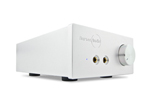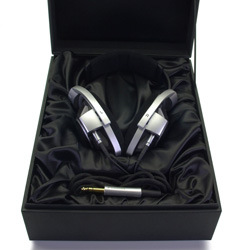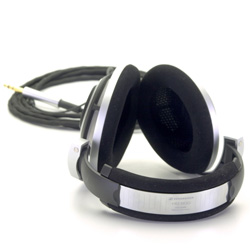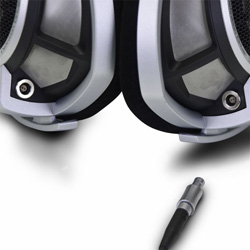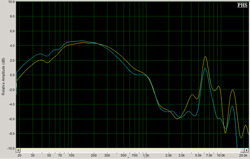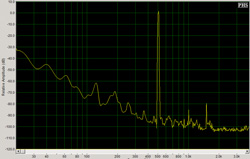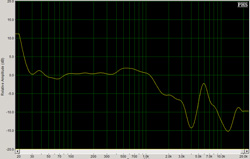Introduction
2009 is a good time to be a headphone fan. The supply of high-end headphones is exploding. At the head of the pack is the new Sennheiser HD-800. This is a cost-no-object assault on the state of the art in headphone listening. They are more than twice as expensive as Sennheiser’s previous top of the line, the HD-650. As I mentioned in my recent review of the Denon AH-D7000s, headphones are guaranteed to produce the highest sound quality for the least money. Even these rather expensive cans are the price of a very modest pair of floorstanding loudspeakers. To cut to the chase, these things deliver. If you’re looking for the best in headphones, these should be at the top of your audition list.
Specifications
- Design: Dynamic, Open, Over the Ear
- MFR: 14 Hz – 44.1 kHz ± 3 dB
- Max SPL: 102 dB @ 1 kHz
- THD+N: 0.02%
- Nominal Impedance: 300 Ohms
- Weight: 9.2 Ounces without Cable
- MSRP: $1,399 USA
Design
The Sennheiser HD-800s cost a not-inconsiderable $1,400. Your money buys you one of the finest made products I have ever held in my hands. They’re like the audio equivalent of a Patek-Philippe watch; every detail has been crafted at the highest level. Most of the headphones are made from machined or cast stainless steel and aluminum. The earpads are covered in Alcantra, and the open backs are covered in a super-fine stainless steel mesh. All the plastics that are in the headphones are very high quality soft touch plastics that would be at home in the interior of a car costing as much as your house. The driver is a 56mm diameter ring radiator with a 40mm magnet and 42mm voice coil, offering frequency response from 14 Hz to 44.1 kHz +/- 3 dB. The -10 dB points are 6 Hz – 51 kHz. The headphone cord uses silver plated OFC wiring with a Kevlar reinforced fabric jacket. The ¼” machined connector, is gold plated at the source end and uses proprietary connectors at the headphone end to allow easy replacement.
As an owner of a pair of HD-580s for many years, this is a very welcome use of “over-engineering.” Nominal impedance is a rather high 300 Ohms. The HD-800s are delivered in a large, fabric covered clamshell box with Alcantra lining, with a beautifully printed manual I’d expect to find in a BMW glove compartment. The earpads are well articulated, and the headband adjustments are as precise as you’d expect. Comfort was first rate, better than my reference Denon AH-D7000s. The earpads always fit perfectly against my head, and the fine adjustment of the headband made it easy to find the perfect setting. By comparison, the Denons always seemed to feel like they were hanging against the side of my head by their headbands. The only drawback was the relatively high 330g (11.6 oz) mass of the headphones, although the exceptional design made the mass feel expensive, not uncomfortable.
Setup
The HD-800s replaced my recently purchased Denon AH-D7000s at my office desk. The Sennheisers were powered by the excellent Headroom Ultra Desktop amplifier with onboard 24 bit- 96 kHz DAC. This amp was discussed in a previous review here, and is a perfect match to these or any other high end headphone. The adjustable preamp gain switch made it easy to get the volume pot into the middle of its range, even with headphone impedances that varied by a factor of more than 10. The amp was fed by a M-Audio Audiophile 2496 soundcard from my office PC. Playback was via Foobar2000 using the ASIO output module to the M-Audio ASIO compatible driver. Source files were lossless Apple Lossless Codec (ALC) or Free Lossless Audio Codec (FLAC) files at either 16 bit 44.1 kHz or 24 bit, 96 kHz. See the Denon/Headroom review for a more in-depth discussion of this computer audio setup. As with the Denons, I played music through the headphones over an entire weekend at moderately high volume level to break-in the driver surrounds.
Sound
Like some of the best audio components in the world, the HD-800s are not flashy. They don’t grab your attention immediately with any specific area of their performance. After a few minutes of listening, it became abundantly clear that these were the most clear, accurate and precise audio transducers I had ever heard. The ability to retrieve detail was astounding, but not in your face. Many hyper detailed audio components draw attention to themselves, especially with bad recordings. The Sennheisers did no favors to bad recordings, but didn’t magnify their shortcomings, either. When listening to good recordings, like the 24/96 Chesky recording of John Faddis’ Remembrances, every last detail and every last instrumental texture was laid bare. This was particularly clear with the simply recorded acoustical instruments of this album. The bass in particular had a wonderful, natural wooden timbre that was not as clearly presented with other headphones or loudspeakers I’ve heard, even my great Denon AH-D7000s.
Lots of albums have “wood” sound in their acoustic bass, but many sound kind of artificial and exaggerated. Not so with this Chesky album, but it did take the HD-800s to really hear all of it. This album was also a great way to hear the HUGE soundstage presented by the HD-800s. A good 50% bigger than even the D7000s, the Sennheisers completely disappeared. There was basically no relation to the things hanging on your head and the sound filling a 1m diameter sphere around your head. Even on produced pop recordings like Jem’s eponymous album and Imogen Heap’s “Speak for Yourself”, the soundstage was just gigantic, with more air and space than I could imagine could come out of a pop recording. There was absolutely no trace of hardness, grain or boom anywhere; just spectacular frequency extension in both directions. The midrange liquidity, particularly with male and female voices, was scary. Listening to one of my old favorites, Tori Amos’ “Unde the Pink”, I got involuntary chills up my back when listening to both “Icicle” and “Yes, Anistasia”, where Amos’ voice was not processed or covered up in any way. It was the closest yet I’ve heard to “real.” And let me remind you that was with a system with a full MSRP of $3000, not including the computer that was the source. Even though that’s expensive for a headphone system, it’s bargain-basement cheap for the performance delivered. The bass was the only place I could find a bone to pick with the HD-800s. They have much better low frequency extension that the bass-champ AH-D7000s, and are guaranteed more accurate in the bass. But the price to pay for their accuracy is that the weight and impact provided by the AH-D7000s was reduced. The Denons provide this quality by delivering a slightly exaggerated bass presentation to make up for the fact that you don’t “feel” bass with headphones. As will be shown in the measurements section, the HD-800s are definitely more accurate.
My tendency towards electronica biases me to the less technically accurate but more pleasing (to me anyway) bass presentation of the Denons. Even though I know they’re not giving me as accurate bass response, the added weight makes the bass sound more realistic (i.e. more like listening to loudspeakers with flat to 20 Hz bass in a listening room). An example of this is Daft Punk’s “Human After All”. With the Denons, I got the same visceral bass sock to the chest (or in this case, the head), I get with my Gallo Reference 3.1s at home. The HD-800s played even deeper, with equally good bass texture, but did not have the same transient impact or power.
On the Bench
As with the Denon AH-D7000s, I did not have the proper equipment to measure the HD-800s. Tyll Herstens and Ivy Burford at Headroom were happy to provide me with their measurements of the HD-800s. These are made with an artificial head system that has microphones located in simulated human ears. They are the most accurate way to measure headphones, but the results require some interpretation. At high frequencies, the ridges and folds in the ear cause response peaks and dips. These are not due to the headphones themselves. Loudspeakers are measured with bare microphones, and therefore do not show these effects. Our brains apply “EQ” to fix these peaks and dips, so flat response ends up sounding flat to us.
If you’re interested in comparisons, Headroom’s website has an interactive graph builder that can overplot measurements of several headphones, drawing data from their extensive database of measurements. Complete sets of acoustical and electronic measurements are available for ALL the headphones Headroom sells (dozens of models).
http://www.headphone.com/buildAGraph.php
The frequency response of the HD-800s goes spectacularly low. Given that headroom’s normalization to 0 dB at 1 kHz seems to be about 3 dB too high to me, the bass gets to its -3 dB point at about 12 Hz (!). The shape of the bass response as compared to the Denons is definitely flatter overall and goes much deeper. The Denons have a broad response plateau which doesn’t roll off at all until 30 Hz, while the HD-800s have a more rounded response with a peak at about 100 Hz.
The harmonic distortion spectrum of a 500 Hz tone shows that the second harmonic peak is at -85 dB, with the third harmonic at -80 dB. The second harmonic peak is 10 dB better than the already fantastic Denons. This performance is just ridiculous, and shows why headphones like the HD-800s NEED a high performance headphone amp. Their intrinsic distortion is so low that anything but the best will end up dominating the distortion of the system. For comparison this level of distortion is something like 25 dB better than what the very best loudspeakers can deliver.
Isolation below 1 kHz is non-existent. These are not headphones for listening in environments with background noise.
Conclusions
If you want the best headphones there are, the road stops at the Sennheiser HD-800s. As of the time of this review, they are the best headphones I have heard, and probably the most accurate audio component I’ve heard regardless of price. $1400 is expensive for a pair of headphones, but $1400 is cheap considering it buys one of the world’s best pieces of audio gear. If you’re into headphones (or even if you’re not), you owe it to yourself to listen to a pair of Sennheiser HD-800s.


